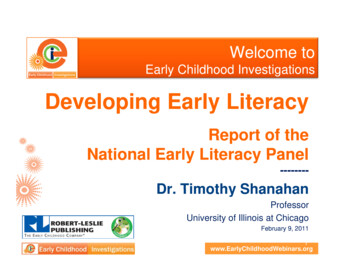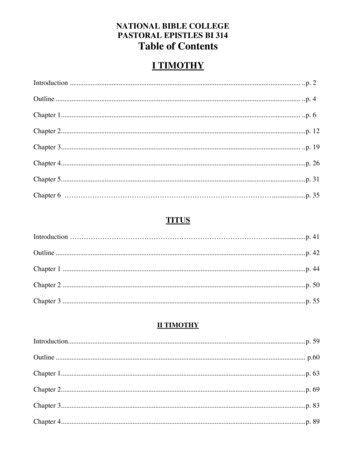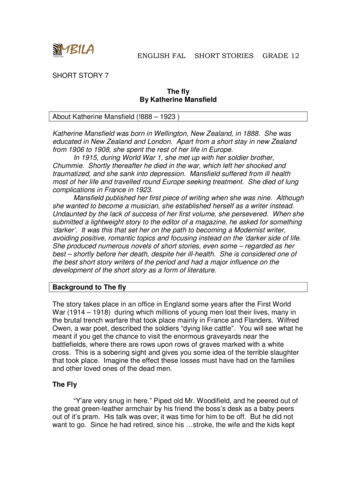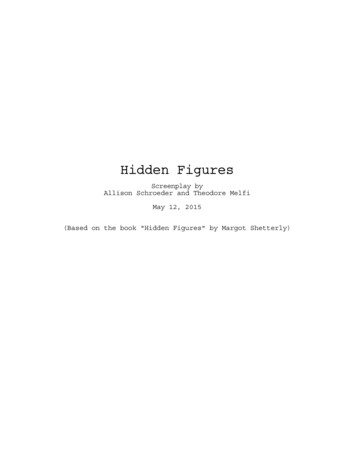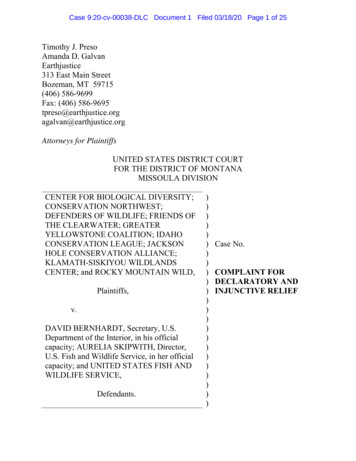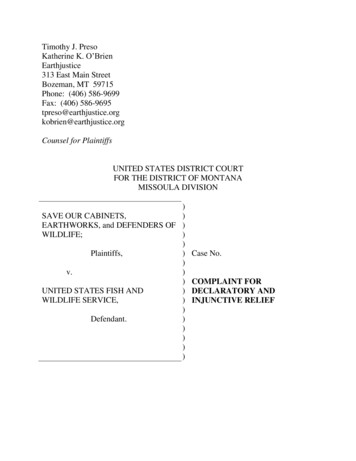
Transcription
Timothy J. PresoKatherine K. O’BrienEarthjustice313 East Main StreetBozeman, MT 59715Phone: (406) 586-9699Fax: (406) e.orgCounsel for PlaintiffsUNITED STATES DISTRICT COURTFOR THE DISTRICT OF MONTANAMISSOULA DIVISION)SAVE OUR CABINETS,)EARTHWORKS, and DEFENDERS OF )WILDLIFE;))Plaintiffs,))v.))UNITED STATES FISH AND)WILDLIFE SERVICE,))Defendant.)))))Case No.COMPLAINT FORDECLARATORY ANDINJUNCTIVE RELIEF
CORPORATE DISCLOSURE STATEMENTPlaintiffs Save Our Cabinets, Earthworks, and Defenders of Wildlife arenon-profit conservation organizations. None of the plaintiff organizations has aparent corporation and no publicly held corporation owns a ten percent or greaterownership interest in any of the plaintiff organizations.
INTRODUCTION1.This case challenges the March 31, 2014, determination by the UnitedStates Fish and Wildlife Service (“FWS”) that the proposed Montanore copper andsilver mine will not jeopardize the survival and recovery of bull trout and grizzlybears listed as threatened species under the Endangered Species Act (“ESA”) oradversely modify designated critical habitat for the bull trout. See U.S. Fish &Wildlife Serv., Final Biological Opinion on the Effects to Bull Trout and BullTrout Critical Habitat From the Implementation of Proposed Actions Associatedwith the Plan of Operations for the Montanore Minerals Corp. Copper/Silver Mine(March 31, 2014) (“Aquatic BiOp”); U.S. Fish & Wildlife Serv., Final BiologicalOpinion on the Effects to Grizzly Bears From the Implementation of ProposedActions Associated with Plan of Operations for the Montanore Minerals Corp.Copper/Silver Mine (March 31, 2014) (“Terrestrial BiOp”).2.The proposed Montanore Mine would transform a remote landscapein the Cabinet Mountains of northwest Montana into a large-scale industrialoperation involving the mining and processing of up to 20,000 tons of ore everyday for up to twenty years. The mine project is proposed in an area of primarilynational forest and federal wilderness lands that contain some of the last remainingundeveloped habitat for imperiled populations of bull trout and grizzly bears in theregion.1
3.As required by section 7 of the ESA, 16 U.S.C. § 1536, FWS issued abiological opinion analyzing the effects of the proposed mine on protected species.Though its biological opinion acknowledged the already precarious status of theaffected bull trout and grizzly bear populations and catalogued substantial adverseimpacts to these populations and their habitat from the Montanore Mine, FWSultimately dismissed the mine’s threats to these protected species. With respect tobull trout, FWS concluded that the mine’s adverse impacts will be inconsequentialbecause the project will affect a subset of the total number of local bull troutpopulations that persist across the Columbia River Basin and its consituentwatersheds. But this conclusion is not supported by any evidence that bull troutpopulations beyond the mine’s reach are adequately abundant, diverse, or welldistributed to ensure that the reduction or loss of local populations affected by themine will not tip the species too far into danger; indeed, the agency facedsubstantial evidence that this is not so. Further, FWS’s conclusion runs counter toits own findings that the bull trout populations and habitat that the Montanore Minewould damage or destroy have unique conservation value, such that theirimportance for the species’ survival and recovery cannot rationally be measuredmerely by the fraction of total bull trout or miles of stream habitat they represent.4.As required by ESA implementing regulations, 50 C.F.R. § 402.14,FWS also determined the extent to which bull trout may lawfully be “taken”—i.e.,2
harmed or killed—as a result of the Montanore Mine. To measure allowable take,FWS decided to rely in part on the extent to which the mine will reduce flows inproject-area streams that harbor bull trout. If the mine reduces stream flows inexcess of the percentages predicted in FWS’s biological opinion, or if flowreductions affect more stream-miles than predicted in the biological opinion, theallowable take level will be exceeded and the agency will be required to re-initiateESA consultation to ensure that the true magnitude of impacts from the mine willnot jeopardize bull trout. However, FWS determined that the mine’s effects onstream flow will not materialize in several critical streams for decades after theproject commences, by which time it will be too late to take action to protect bulltrout from flow reductions that prove larger than FWS predicted. Accordingly,predicted stream flow reductions cannot serve the regulatory function of a metricfor take, which is to signal to the agency if the mine’s effects on protected speciesprove more severe than anticipated. By the time the agency can ascertain whetherthe mine will cause more damage to bull trout-occupied streams than predicted inthe biological opinion, the damage to the species will be irreversible.5.Regarding grizzly bears, FWS concluded that the mine’s greatestthreat will be a substantial increase in human use of grizzly bear habitat andassociated risks of human-caused mortality due to poaching, mistakenidentification by hunters, and the killing of bears because of a real or perceived3
need for self defense. Yet the agency dismissed this threat to a population of bearsthat already teeters on the brink of extinction because the mine proponent haspromised to fund a suite of public education and related measures that aim toreduce conflicts between humans and grizzly bears in the Cabinet Mountainsregion. FWS concluded that implementing the mine project and associated conflictreduction measures will ensure a net reduction in human-caused grizzly bearmortality across the affected ecosystem. This conclusion, however, is notsupported by evidence regarding the number of grizzly bears that are likely to bekilled as a result of the mine or the extent to which the promised conflict reductionmeasures can prevent human-caused mortalities. Further, FWS’s assertion thatmitigation measures can neutralize the substantial increase in human-causedmortality risks from the mine is contradicted by evidence that implementing thekey conflict reduction strategies relied on in the biological opinion over the pastseven years has failed to reduce the number of human-caused grizzly bear deaths inthe Cabinet Mountains region.6.The Cabinet Mountains region offers one of the last remainingstrongholds for bull trout and grizzly bears in northwest Montana, yet populationsof both species already are hanging on by a thread. FWS’s conclusion thatinterposing a massive mining operation into this landscape will not jeopardize the4
survival or recovery of either species lacks foundation in the record, contradicts theagency’s own findings, and thereby violates the ESA.JURISDICTION AND VENUE7.Plaintiffs bring this action pursuant to the judicial review provisionsof the Administrative Procedure Act, 5 U.S.C. §§ 701-706, which waive thedefendants’ sovereign immunity.8.This Court has jurisdiction over plaintiffs’ claims pursuant to 28U.S.C. § 1331 (federal question) and may issue a declaratory judgment and furtherrelief pursuant to 28 U.S.C. §§ 2201-2202.9.Venue lies in the District of Montana because plaintiff Save OurCabinets is headquartered in Montana; the lands at issue in this suit are located inSanders County, Montana; and a substantial part of the events giving rise toplaintiffs’ legal claims occurred in the District of Montana. 28 U.S.C.§ 1391(e)(1).PARTIES10.Plaintiff Save Our Cabinets is a Montana non-profit organizationdedicated to protecting wild lands, wildlife, and water quality in the CabinetMountains of northwest Montana, especially the Cabinet Mountains WildernessArea. Save Our Cabinets is headquartered in Heron, Montana.5
11.Plaintiff Earthworks is a non-profit organization dedicated toprotecting communities and the environment from the adverse effects of mineraldevelopment. Earthworks is headquartered in Washington, D.C., and has fieldoffices across the country, including Missoula, Montana. Earthworks has a longhistory of advocacy concerning hard rock mining in the Cabinet-Yaak region ofnorthwest Montana to protect public health, fish, wildlife, and clean water—including throughout the permitting process for the proposed Montanore Mine.Earthworks members live and recreate in northwest Montana, including theCabinet Mountains area.12.Plaintiff Defenders of Wildlife (“Defenders”) is a national nonprofitconservation organization headquartered in Washington, D.C., with officesthroughout the country, including Missoula, Montana. Defenders has more than393,000 members, including 1,698 in Montana. Defenders is a science-basedadvocacy organization focused on conserving and restoring native species and thehabitat on which they depend, and has been involved in such efforts since theorganization’s establishment in 1947. Defenders has advocated for grizzly bearrecovery at least since grizzlies were listed as threatened under the EndangeredSpecies Act. These efforts include establishing a grizzly bear compensationprogram in 1997 to pay ranchers for livestock losses to grizzlies, for whichDefenders has paid more than 400,000; and an extensive on-the-ground conflict6
reduction program in which Defenders has invested more than 500,000 toimplement more than 250 projects, including several in the Cabinet-Yaak grizzlybear recovery area. Defenders also has commented on numerous managementplans affecting grizzly bears, including those relevant to the Cabinet-Yaak grizzlypopulation and recovery area.13.Plaintiffs have a longstanding interest in the preservation and recoveryof bull trout and grizzly bears in the Northern Rocky Mountains region, includingthe Cabinet-Yaak ecosystem in northwest Montana. Plaintiffs actively seek toprotect and recover bull trout and grizzly bears through a variety of actionsincluding public outreach and education, investment in conflict reductionmeasures, scientific analysis, advocacy, and when necessary, litigation. Plaintiffshave participated actively in available public comment processes concerning theproposed Montanore Mine and its effects on bull trout and grizzly bears, includingby filing extensive comments on the proposed and final environmental impactstatements and draft record of decision for the Montanore Mine issued by the U.S.Forest Service.14.Plaintiffs’ members, staff, and volunteers use and enjoy the CabinetMountains Wilderness and surrounding national forest lands for a wide range ofactivities, including recreational pursuits such as hiking, camping, backpacking,bird watching, and wildlife watching (including observation of bull trout and7
grizzly bears); as well as spiritual renewal and aesthetic enjoyment. Plaintiffs’members, staff, and/or volunteers have viewed bull trout and grizzly bears or signsof grizzly bear presence in and around the Cabinet Mountains Wilderness and haveengaged in extensive scientific, educational, and advocacy efforts aimed atmaintaining a healthy and intact ecosystem in the Cabinet Mountains that supportsnative fish and wildlife. By issuing a biological opinion that allows the MontanoreMine project to proceed in a manner that jeopardizes the survival and recovery ofbull trout and grizzly bears, FWS’s actions will harm Plaintiffs’ interest in viewingbull trout and grizzly bears and maintaining a healthy and intact ecosystem in theCabinet Mountains. Accordingly, the legal violations alleged in this complaintcause direct injury to the aesthetic, conservation, recreational, scientific,educational, and wildlife preservation interests of the Plaintiffs and their members,staff, and volunteers.15.The aesthetic, conservation, recreational, scientific, educational, andwildlife preservation interests of Plaintiffs and their members, staff, and volunteershave been, are being, and unless their requested relief is granted, will continue tobe adversely and irreparably injured by FWS’s failure to comply with federal law.These are actual, concrete injuries that are traceable to FWS’s conduct and wouldbe redressed by the requested relief. Plaintiffs have no adequate remedy at law.8
16.Defendant U.S. Fish and Wildlife Service is an agency of the UnitedStates Department of Interior and is responsible for administering the provisions ofthe ESA with regard to freshwater aquatic and terrestrial species, including bulltrout and grizzly bears.STATUTORY FRAMEWORK17.Congress enacted the Endangered Species Act, 16 U.S.C. §§ 1531-1544, to “provide a program for the conservation of endangered species andthreatened species” and to “provide a means whereby the ecosystems upon whichendangered species and threatened species depend may be conserved .” Id.§ 1531(b). The ESA “obligates federal agencies ‘to afford first priority to thedeclared national policy of saving endangered species.’” Pac. Coast Fed’n ofFishermen’s Ass’ns v. U.S. Bureau of Reclamation, 426 F.3d 1082, 1084-85 (9thCir. 2005) (quoting Tenn. Valley Auth. v. Hill, 437 U.S. 153, 185 (1978)).18.Section 7 of the ESA prohibits federal agencies from takingdiscretionary actions that would “jeopardize the continued existence of anyendangered species or threatened species” or cause the “destruction or adversemodification” of habitat designated as “critical” for such species. 16 U.S.C.§ 1536(a)(2). An agency action “jeopardizes” a protected species if it “reasonablywould be expected, directly or indirectly,” to reduce appreciably the species’likelihood of survival or recovery “by reducing the reproduction, numbers, or9
distribution of that species.” 50 C.F.R. § 402.02; see Nat’l Wildlife Fed’n v. Nat’lMarine Fisheries Serv., 524 F.3d 917, 932 (9th Cir. 2007) (holding that significantimpairment of species’ recovery prospects alone may constitute jeopardy).19.To enforce this substantive mandate, “[a]n agency’s decision whetherto take a discretionary action that may jeopardize endangered or threatened speciesis strictly governed by ESA-mandated inter-agency consultation procedures.”Forest Guardians v. Johanns, 450 F.3d 455, 457 (9th Cir. 2006) (citations omitted);see 16 U.S.C. § 1536 (establishing consultation requirements). If the proposedaction is expected to affect a protected species, the agency must initiate formalconsultation with the appropriate federal wildlife agency, which is FWS forfreshwater and terrestrial species such as bull trout and grizzly bears, 50 C.F.R.§ 402.01(b).20.The consultation process culminates in the issuance of a biologicalopinion, in which FWS must determine—based on “the best scientific andcommercial data available,” 16 U.S.C. § 1536(a)(2)—whether the proposed actionwill jeopardize the survival and recovery of a protected species, id. § 1536; 50C.F.R. § 402.02. In its biological opinion, FWS also must determine whether theproposed action will destroy or adversely modify a protected species’ designatedcritical habitat. 50 C.F.R. § 402.14(g)(4); see 16 U.S.C. §§ 1532(5)(A) (defining“critical habitat”), 1533(a)(3)(A) (directing Interior Secretary to promulgate10
regulations designating critical habitat for listed species). “The purpose ofdesignating ‘critical habitat’ is to set aside certain areas as ‘essential’ for thesurvival and recovery of the threatened species,” and provide for the protection ofthose areas through the section 7 consultation process. Gifford Pinchot Task Forcev. U.S. Fish & Wildlife Serv., 378 F.3d 1059, 1075-76 (9th Cir. 2004) (citing 16U.S.C. § 1532(5)). Destruction or adverse modification occurs “when an actioncauses ‘appreciable diminishment’ of the value of critical habitat for survival orrecovery.” Rock Creek Alliance v. U.S. Forest Serv., 703 F. Supp. 2d 1152, 1192(D. Mont. 2010) (“Rock Creek Alliance II”) (emphasis in original) (quotingGifford Pinchot Task Force, 378 F.3d at 1069-70), aff’d in part 663 F.3d 439 (9thCir. 2011); see 50 C.F.R. § 402.02.21.If FWS concludes that a proposed action is likely to jeopardize aprotected species or destroy or adversely modify its critical habitat, the action maynot proceed as proposed. See 16 U.S.C. § 1536(a)(2). In that circumstance, FWSmust determine whether a “reasonable and prudent alternative” to the proposalexists that would avoid jeopardy to the species and destruction or adversemodification of critical habitat. Id. § 1536(b)(3)(A).22.If FWS concludes that implementing the proposed action (or theidentified reasonable and prudent alternative) will not jeopardize protected speciesand will not destroy or adversely modify critical habitat, the agency must include11
in its biological opinion an “incidental take statement,” which specifies the amountor extent of any “taking” of protected species that may be authorized as a result ofthe action. 50 C.F.R. § 402.14(i)(1). Under the ESA, “take” means “to harass,harm, pursue, hunt, shoot, wound, kill, trap, capture, or collect” a protected species“or to attempt to engage in any such conduct.” 16 U.S.C. § 1532(19). The takingof protected species is prohibited unless specifically authorized in an incidentaltake statement. Id. §§ 1538(a)(1)(B), 1539. Accordingly, the amount of takeauthorized in an incidental take statement serves as a “‘trigger’ that, when reached,results in an unacceptable level of incidental take .” Ariz. Cattle Growers Ass’nv. U.S. Fish & Wildlife Serv., 273 F.3d 1229, 1249 (9th Cir. 2001). In thatcircumstance, the protection from take liability provided by the incidental takestatement lapses and the federal agencies must re-initiate consultation undersection 7 to ensure that the proposed action will not jeopardize the affected species.Id.; see 50 C.F.R. § 402.16(a).THE MONTANORE MINE23.The Montanore Minerals Corporation (“MMC”) proposes to constructa copper and silver mine that would bore under the Cabinet Mountains Wildernessarea in the Kootenai National Forest approximately 18 miles south of Libby,Montana. The mine would operate seven days per week for sixteen to twentyyears, extracting up to 20,000 tons of ore each day. In addition to the mine adits,12
the Montanore project would require construction of approximately 14 miles ofhigh-voltage electric transmission line, waste rock storage facilities, a wastewatertreatment plant, wastewater holding and seepage collection ponds, pipelines fortransporting water and mine tailings, and tailings storage facilities; paving andwidening of approximately 13 miles of roads; and associated clearing of trees andvegetation.24.This large-scale industrial operation would disturb more than 1,500acres of land in a remote area of northwest Montana that presently is characterizedby pristine expanses of glaciated peaks, forested valleys, and rivers and streamsthat are among the top 5% purest waters in the continental United States. The areaof the proposed mine is home to countless species of plants and abundant nativewildlife, including mountain goats, bighorn sheep, pikas, wolverines, elk, moose,deer, mountain lions, and wolves. And it is one of the last remaining undevelopedhabitats for the region’s imperiled populations of bull trout and grizzly bears.25.Because the proposed action will affect bull trout and grizzly bearpopulations protected under the ESA, the U.S. Forest Service, which is the leadfederal agency with authority to permit the mine, initiated section 7 consultationwith FWS in 2011. On March 31, 2014, FWS issued the challenged biologicalopinion, in which it determined that the proposed Montanore Mine will not13
jeopardize the survival or recovery of bull trout or grizzly bears and will notdestroy or adversely modify bull trout critical habitat.FACTS RELATING TO BULL TROUT CLAIMSI.BULL TROUT STATUS AND CONSERVATION NEEDS26.The bull trout, Salvelinus confluentus, is the Northwest’s largestmigratory char (a close relative of trout). Historically, bull trout thrived in majorriver drainages from northern California and Nevada north to Alaska, and fromPuget Sound on the Pacific coast east to Montana and Alberta.27.Bull trout exhibit both resident and migratory life-history strategies.Resident bull trout spend their entire life cycle in the stream in which they spawnand rear. Migratory bull trout, in contrast, spend one to four years in their natalstream before migrating to mature in a lake, river, or—in some coastal areas—theocean. Migratory bull trout tend to be larger than resident fish—commonlyexceeding two feet in length—and produce more eggs, thereby contributing alarger share to population levels than resident fish. Migratory bull trout alsofacilitate genetic exchange and have the capacity to replenish isolated residentpopulations that are diminished by environmental disturbances. For these reasons,FWS has determined that the persistence of migratory bull trout is critical to thespecies’ survival and recovery.14
28.Compared to other salmonids, bull trout have highly specific habitatrequirements. To spawn, develop, and survive, bull trout require water that is verycold—optimally 35 to 39 degrees Fahrenheit—and very clean. As discussed inmore detail infra, excess sediment suspended in stream water or deposited onstream bottoms impairs bull trout spawning, feeding, and other vital behaviors andis fatal to bull trout at high levels. In addition, bull trout are acutely sensitive tostream flow reductions, which can exacerbate stream warming, concentratepollutants, and produce seasonally dry reaches that cut off access to essentialhabitat. Bull trout also are sensitive to changes in streamside vegetation, streamchannel form and stability, and impediments in their migratory corridors.29.These specific habitat requirements make bull trout uniquelyvulnerable to environmental disturbance. Land use activities that degrade waterquality or reduce stream flows—such as mining, road building and maintenance,logging, irrigation, grazing, and residential and commercial development—havecaused dramatic declines in bull trout population levels. In addition, dams nowblock many bull trout migration corridors, leading to the loss of most migratorypopulations across the species’ range. As a result, FWS’s most recent bull troutstatus assessment concluded that approximately seventy-two percent of bull trout“core area” populations—which consist of one or more interbreeding localpopulations and are the basic units on which FWS gauges the species’ recovery—15
are at risk or at high risk of extirpation. FWS determined that just 3.3% of corearea populations across the species’ range are at low risk of extirpation. Due tothis precarious status, bull trout throughout the coterminous United States are listedas a threatened species under the ESA. 64 Fed. Reg. 58,910 (Nov. 1, 1999).30.The pattern of declining numbers, contracting range, and loss of lifehistory diversity that affects the species across its range is replicated within theColumbia River Basin, where the Montanore Mine is proposed. FWS hasdesignated the Columbia River Interim Recovery Unit as one of five bull troutpopulation segments that are essential for the survival and recovery of the species.Yet throughout this recovery unit local populations of bull trout are at best stableand more often declining. Bull trout have been extirpated from an estimated 55%of their historic range within the Columbia River Basin and many of the fish thatremain persist in small, isolated populations that are highly vulnerable toextirpation.31.The watershed surrounding the site of the proposed Montanore Mineoffers one of the few large-scale undeveloped habitats for bull trout that remain inthe Columbia River basin. Nevertheless, the effects of past habitat destruction andfragmentation have left the two bull trout core area populations that the MontanoreMine would affect in a precarious state: According to FWS’s most recentassessment, the Kootenai River Core Area population already is “at risk” of16
extirpation due to very limited and/or declining numbers, range, and/or habitat.The Lower Clark Fork River Core Area population is “at high risk” of extirpationdue to rapidly declining range and extremely limited bull trout numbers.32.Within these vital but already diminished core areas, the MontanoreMine would harm local bull trout populations whose special conservation valueFWS has recognized. Within the Kootenai River Core Area, the mine wouldthreaten local bull trout populations in West Fisher River and in Libby Creek,which FWS considers “an important primary bull trout spawning and rearingstream,” Aquatic BiOp 124, and is one of the few streams in the Columbia RiverBasin that continues to support both migratory and resident bull trout. Within theLower Clark Fork River Core Area, the mine would affect local bull troutpopulations in Rock Creek and East Fork Bull River. These streams, too, areamong the few in the basin that still harbor migratory bull trout essential for thespecies’ survival, and substantial private and public investments have been made inefforts to reduce habitat fragmentation from dams that threatens these migratoryfish. East Fork Bull River is considered “the single-most important bull troutspawning and rearing stream in the Lower Clark Fork bull trout core area.” U.S.Dep’t of Interior Comments on Supp. Envtl. Impact Statement for the MontanoreProject 2 (Nov. 15, 2011). The Bull River supports more bull trout spawning thanany other stream in the core area, with the greatest concentration of spawning and17
egg incubation occurring in its East Fork. Accordingly, the challenged biologicalopinion acknowledges that “[m]aintaining spawning and rearing success in thesetwo local populations is essential to maintaining the existing survival status andpotential for recovery of the [Lower Clark Fork River] bull trout core areapopulation.” Aquatic BiOp 122.33.The proposed Montanore Mine also would degrade designated bulltrout critical habitat within the Kootenai and Lower Clark Fork River watersheds.Like the local bull trout populations it supports, the affected critical habitat—located in Libby Creek, Bear Creek, West Fisher Creek, Rock Creek, and EastFork Bull River—is both uniquely important for bull trout conservation andalready severely degraded. FWS considers the designated critical habitat in theLower Clark Fork River watershed, of which Rock Creek and East Fork Bull Riverare a part, “essential” for maintaining bull trout distribution within the ColumbiaRiver Basin. Id. at 46. This habitat is uniquely important to bull troutconservation because it encompasses the “evolutionary heart” of the migratoryadfluvial life history form, id.—meaning bull trout that migrate from their natalstream to reside in lakes as adults and then return to headwater streams to spawn.The designated critical habitat in the Lower Clark Fork River basin also is“essential to bull trout conservation” because it provides “an important portion ofthe spawning and rearing habitat for Lake Pend Oreille”—a stronghold for the18
struggling species in the Columbia River basin—“as well as an essential migratorycorridor for bull trout from Lake Pend Oreille to be able to access productivewatersheds upstream .” Id. at 47. FWS likewise has determined that thedesignated critical habitat in the Kootenai River Basin is “essential to bull troutrecovery” because it supports the strongest adfluvial population across the species’range and the single largest spawning run of adult bull trout in the Columbia RiverBasin. Id. at 46.34.However, even without the adverse impacts of the Montanore Mine,the critical habitat in these watersheds has already been degraded to the point thatit is functioning “at risk” or “at unacceptable risk” for purposes of bull troutconservation. Under FWS’s rubric, habitat that is functioning “at risk” maysupport isolated bull trout populations but may require active or passive restorationto support the species’ recovery. In habitat that is functioning “at unacceptablerisk,” bull trout have been extirpated or are present only rarely or in low numbers.Active restoration of such habitat is necessary to begin recovering the species.35.FWS published a bull trout recovery plan in 2002, which describesthose actions the agency believes are reasonable and necessary to conserve thespecies. The recovery plan stresses that local bull trout populations have beenextirpated in major portions of the Clark Fork River watershed, with many of theremaining populations so small as to seriously reduce the chance that they will19
recolonize formerly occupied habitat. Accordingly, the recovery plan calls for asustained net increase in bull trout abundance and distribution within the ClarkFork River watershed in order to ensure the species’ long-term survival andrecovery. Regarding the Kootenai River watershed, the recovery plan similarlystates that increasing bull trout abundance and restoring distribution of keypopulations is necessary to ensure the species’ long-term conservation. To thatend, the recovery plan calls for, among other strategies, reducing sedimentation,cleaning up existing mine waste, improving instream flows, and actively restoringinstream habitat in the same bull trout streams that the proposed Montanore Minewould further degrade.II.FWS’S CHALLENGED DETERMINATIONS CONCERNING BULLTROUT36.In the challenged biological opinion, FWS described numerousadverse effects that the Montanore Mine would inflict on bull trout and bull troutcritical habitat in the Lower Clark Fork and Kootenai River watersheds. Theseeffects include permanent stream flow reductions that would damage habitatquality and choke off access to valuable upstream areas, particularly for the largerand more fecund migratory bull trout; increased stream temperatures due to flowreductions and substantial discharges of treated mine wastewater that will beunacceptably warm for bull trout; s
12. Plaintiff Defenders of Wildlife ("Defenders") is a national nonprofit conservation organization headquartered in Washington, D.C., with offices throughout the country, including Missoula, Montana. Defenders has more than 393,000 members, including 1,698 in Montana. Defenders is a science-based

